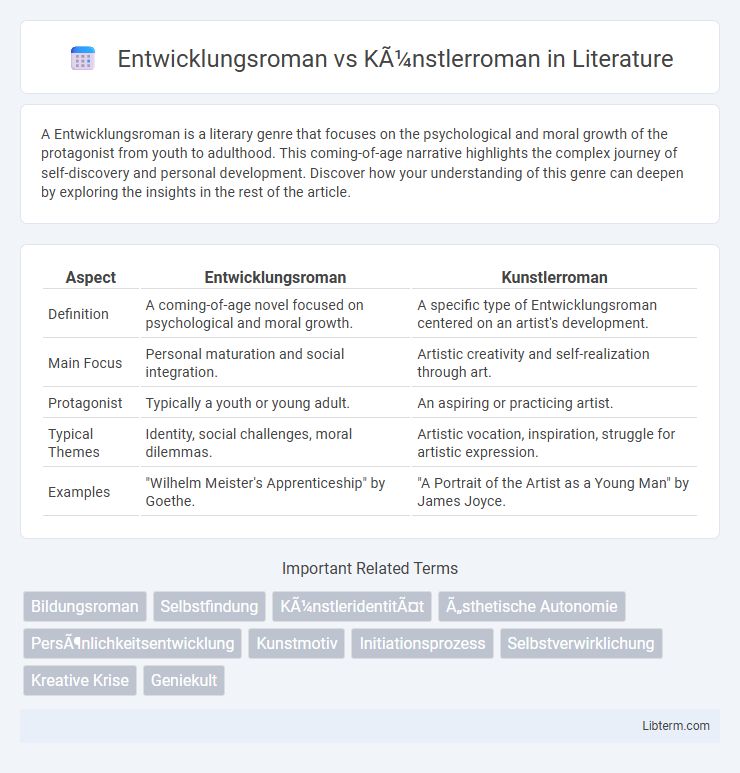A Entwicklungsroman is a literary genre that focuses on the psychological and moral growth of the protagonist from youth to adulthood. This coming-of-age narrative highlights the complex journey of self-discovery and personal development. Discover how your understanding of this genre can deepen by exploring the insights in the rest of the article.
Table of Comparison
| Aspect | Entwicklungsroman | Kunstlerroman |
|---|---|---|
| Definition | A coming-of-age novel focused on psychological and moral growth. | A specific type of Entwicklungsroman centered on an artist's development. |
| Main Focus | Personal maturation and social integration. | Artistic creativity and self-realization through art. |
| Protagonist | Typically a youth or young adult. | An aspiring or practicing artist. |
| Typical Themes | Identity, social challenges, moral dilemmas. | Artistic vocation, inspiration, struggle for artistic expression. |
| Examples | "Wilhelm Meister's Apprenticeship" by Goethe. | "A Portrait of the Artist as a Young Man" by James Joyce. |
Definition of Entwicklungsroman
Entwicklungsroman is a literary genre that depicts the psychological and moral growth of the protagonist from youth to adulthood, emphasizing personal development and self-discovery. Unlike Kunstlerroman, which centers specifically on the maturation of an artist and creative identity, Entwicklungsroman explores a broader range of life experiences and character growth. Key examples include Goethe's "Wilhelm Meister's Apprenticeship," illustrating the protagonist's journey toward maturity and self-awareness.
Definition of Künstlerroman
Kunstlerroman is a specific subgenre of the Bildungsroman that focuses on the development and maturation of an artist rather than a general coming-of-age story. It explores the protagonist's journey in refining their creative talents and confronting societal challenges that influence their artistic identity. This genre highlights the intimate connection between personal growth and the evolution of artistic expression.
Historical Origins and Evolution
The Entwicklungsroman, emerging in the 18th century, traces the protagonist's psychological and moral growth from youth to adulthood, exemplified by Goethe's "Wilhelm Meister's Apprenticeship." The Kunstlerroman, a specialized subgenre developing in the 19th century, centers on the maturation of an artist, highlighting creative struggles and self-discovery as seen in James Joyce's "A Portrait of the Artist as a Young Man." Both genres evolved alongside Romanticism and Realism, reflecting shifts in societal values and individual identity concepts through literary history.
Key Themes and Motifs
Entwicklungsroman centers on the protagonist's psychological and moral growth, often highlighting themes of self-discovery, social integration, and personal maturation. Kunstlerroman specifically explores the artist's creative development, emphasizing motifs of artistic passion, inner conflict, and the struggle between individual expression and societal expectations. Both genres use symbolic elements to depict transformation but differ in focusing on general life experience versus artistic identity.
Character Development in Both Genres
Entwicklungsroman emphasizes a protagonist's psychological growth and moral maturation through life experiences, highlighting internal conflicts and social integration. Kunstlerroman centers on the artist's creative and personal development, exploring the struggles of artistic identity and self-expression within cultural contexts. Both genres portray profound character evolution but differ by focusing on general maturation versus specialized artistic growth.
Narrative Structure and Perspective
Entwicklungsroman centers on the protagonist's psychological and moral growth through a linear, chronological narrative that emphasizes internal conflict and self-discovery. Kunstlerroman, a subgenre of Entwicklungsroman, specifically traces the artistic development and creative struggles of the protagonist, often employing a more introspective and fragmented narrative perspective to explore the complexities of artistic identity. Both genres utilize first-person or close third-person perspectives to provide intimate insight into the protagonist's evolving self-concept within social and cultural contexts.
Prominent Examples of Entwicklungsroman
Prominent examples of Entwicklungsroman include Johann Wolfgang von Goethe's "Wilhelm Meister's Apprenticeship," which chronicles the protagonist's personal growth and self-discovery, and Charles Dickens's "Great Expectations," depicting Pip's moral and psychological development through various life trials. Unlike the Kunstlerroman, which centers on an artist's creative maturation, the Entwicklungsroman broadly explores a young individual's progression into adulthood, emphasizing emotional and intellectual growth. These novels highlight key themes of identity formation, social integration, and the pursuit of purpose within the Bildungsroman tradition.
Notable Works of Künstlerroman
Kunstlerroman, a subgenre of Bildungsroman, centers on the artistic development of its protagonist, portraying the struggles and growth unique to creative individuals. Notable works of Kunstlerroman include James Joyce's "A Portrait of the Artist as a Young Man," Hermann Hesse's "Steppenwolf," and Gustave Flaubert's "Sentimental Education," each highlighting the evolution of an artist's identity and craft. These novels explore the tension between societal expectations and personal expression, emphasizing the protagonist's journey toward self-realization through art.
Similarities and Differences
Entwicklungsroman and Kunstlerroman both explore the protagonist's personal growth but differ in thematic focus and narrative scope. Entwicklungsroman emphasizes the character's psychological and moral development through life experiences, while Kunstlerroman centers on the artist's creative maturation and struggles within the artistic community. Both genres highlight self-discovery but contrast broad life formation with specialized artistic evolution.
Impact on Literary Tradition
The Entwicklungsroman, centered on a protagonist's psychological and moral growth, established a foundational narrative structure influencing 19th and 20th-century literature by emphasizing individual development within societal contexts. The Kunstlerroman, a specialized subset focusing on an artist's formation, deepened literary explorations of creativity, self-expression, and the Artisan's role, shaping modernist and postmodernist portrayals of artistic identity. Together, these genres expanded narrative complexity and character introspection, enriching literary tradition through nuanced depictions of personal and artistic evolution.
Entwicklungsroman Infographic

 libterm.com
libterm.com